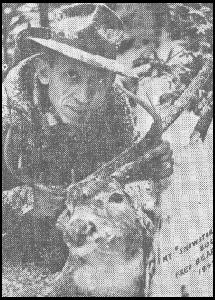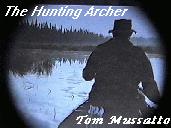
Hunting Arrows
by
Fred Bear

The article by Tom Imler in the December issue of Ye Sylvan Archer is very timely. Modern archery hunting is "on trial" and care should be taken by all those who enjoy this sport to make sure that their equipment is adequate for the game hunted.
Too few archers realize the importance of using a rather heavy arrow for hunting. The growing popularity of field shooting has created a demand for light weight, fast arrows and it is assumed by many archers that the same qualifications are proper for hunting. It is also a more or less common belief that a light arrow traveling fast will have as great killing power as a heavier shaft going at slower speed when both are shot from the same how.
In support then, of Tom Imler's arguments for heavy tackle I would like to submit a chapter dealing with arrows from the manuscript of a book being prepared on Bow Hunting.
"In 1980, F. L. English conducted a series of tests to determine the striking power of various weights of arrows when shot from a how having a draw weight of 50 pounds. This being classed as a light weight hunting bow and in as much as only one bow was used it was thought desireable to conduct similar tests using not only arrows of various weights, but bows of varying weights as well.
"Accordingly, a 'bob' was constructed by nailing together 4 pieces of wood resulting in a box 9 inches square and 15 inches long, open at both ends. This was filled with pieces of corrugated paper cut into squares which were kept in place by narrow slats nailed across the top and bottom of the ends leaving a sufficient amount of corrugated paper exposed to receive the arrows.
"This bob was suspended, pendulum fashion, from 4 wires running to the ceiling (about 10 feet). A light weight wire 'whisker' with a small piece of pencil lead attached was hinged to the back end so that it had a vertical travel only. The pencil end rested on a piece of graph paper just slightly below and back of the bob.
"Six arrows were made weighing 300, 400, 500, 600, 700, and 800 grains each. All shooting was done from a machine so that the draw and loose would be exactly the same for each shot,
"Eight bows, varying in weight from 45 to 68 pounds were used.
"The six arrows were shot from each bow and the performance of each recorded. The results were then grouped for each arrow weight, added together and divided by 8 to give averages which revealed the following.
"The 400 grain arrow struck 20 per cent harder than the 300 grain, the 500 45 per cent, the 600 66 per cent, the 700 82 per cent the 800 100 per cent.
"In order that the reader may more completely comprehend the startling results revealed by these experiments, figure 1 shows a chart indicating the findings for each different combination.
"A study of this will show the striking force of a 500 grain arrow shot from a 61 pound bow to be less than l per cent greater than a 600 grain arrow shot from a 45 pound bow. Also that a 68 pound how with 500 grain arrow strikes less than 3 per cent harder than a 52 pound bow with a 600 grain arrow.
"The rcason for this difference, of course, is because the light arrow does not absorb nearly as much of the energy of the bow as does the heavy one.
"To the casual observer it may seem that the recommendations as to bow weights in the chapter dealing with bows should not have been made, as arrow weight has a greater bearing on killing power. This would be true perhaps, if it were not necessary, from an accuracy standpoint, to establish a definite relationship between bow weight and arrow weight. A good rule to follow in this respect is to select arrows that are not heavier in grains than your bow weight with a cipher added to it, and not lighter than 10 per cent less. As an example, in choosing hunting arrows for a 60 puund bow you simply add a cipher to the 60 which allows a maximum arrow weight of 600 grains and a minimum of 540 grains.
"Arrows that are heavier than this ratio will most likely have too high a trajectory and for this reason will be difficult to shoot accurately cxcept at close range. If much lighter than the above recommendations they may lack sufficient killing power for large game and, under hunting conditions, be less accurate.
"Lightweight arrows are more inaccurate under hunting conditions because they are not as stable as the heavier shafts. Hunting shots differ from practice or field shooting. In the former it is the first shot that counts most because, in many instances, an opportunity for a second shot does not occur.
"Upon that first shot therefore hinges your success or failure and it is here that the heavier shaft will aid your accuracy. Being less sensitive to correct loose and form which, you may rest assured will not be at its best, your chances of scoring a hit are much better and you are more certain to get your trophy.
"It might be well to mention again, as in the chapter under bows, that a deer can be killed with most any combination if no heavy bones are struck but what is needed is some thing that will crash through where the going is tough.
"Some archers will take exception to these recommended arrow weights, arguing that the heavier shafts, because or their faster drop will greatly affect the accuracy. It is the opinion of the writer, backed by many of the most successful archer hunters that, in-as-much as very little game is killed with a how beyond 40 yards, the more stable shooting qualities of heavier shafts will more than compensate for any loss of accuracy due to a greater drop. And you will recover many trophies that might otherwise escape wounded,
"It is not necessary to construct a hob to arrive at this conclusion. Watch how a heavy bow rocks a target or try to shoot light weight blunts through a board.
"The heavier arrows with their additional penetrating power are more likely to pass entirely through large and heavy game animals. Experience has proven that deer will go further if they carry the arrow with them than they will if it clears the body. The logical reason for this is that the arrow frightens them. The sharp blade is felt at each movement and, with the brightly colored shaft and feathers protruding from their body, it might easily be imagined that some strange creature were clinging to their body and clawing at their 'innards'. In this frantic condition they will run until the very last heartbeat and you may not locate your game unless tracking conditions are good.
"On the other hand, the swift almost silent passage
of an arrow thru the body will, in most cases, have the same effect as
a pain and sick feeling in the stomach would to you or me. A sensible reaction
would be to lie down at the first convenient place you could find. Animals
will do this too and if not pursued at once will he found within a short
distance from where they were hit.
"It is true that a protruding arrow will cause additional
cutting when the rear end comes in contact with trees and bushes. This
will hasten death. However, it may, also lengthen the distance to your
trophy as much as five times."
The majority of archers in this area do use heavy equipment
although our interpretation of the word as applied to hunting equipment
means bows 65 to 70 pounds.
I go along with Tom all the way with the exception of
his statement that "most normal men can use a 70 to 80 pound how with
ease."
If this figure had been 60 to 70 pounds it would, in my
opinion, be nearly right.
Most men do not have the bone structure to support muscular
development necessary to shoot bows of more than this weight with ease.
While many could work into the 80 pound class and some to the 90 or 100,
few have the time to devote to this task.
There is absolutely no question but that the really heavy
bows do pack a tremendous wallop; and bows, unlikc guns, can never be too
heavy for the archer.
So, in establishing minimum bow weights for game no larger
than deer, let us not place them so high as to discourage the archer hunter
who does not have quite so much hair on his chest, or those who do not
have enough time to devote to this muscular build-up.
It is entirely another question if one plans to tangle
with the big bears, moose, large boar and such game, but the largest game
that the majority of archers will ever have occasion to shoot at are deer
and, very occasionally, black bear.
Don't get me wrong, there is definitely no substitute for heavy bows and heavy arrows. A light weight arrow traveling faster will not bring the desired results. But let us not insist that moose tackle be used for deer and that nothing less will suffice.

